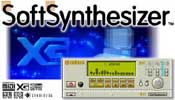BETTER MIDI SOUNDS WITH XG MIDI:
XG is a new MIDI standard developed by Yamaha which gives much more editing control over your MIDI sequences.
It is basically an extension of the GM General MIDI standard which has been very successful over the past few years.
Whereas the GM standard has support for 128 voices - XG makes use of Bank Select messages to access literally hundreds of extra sounds.
These Bank Select messages are difficult for many users to understand so Evolution has made them very easy.
You simply click on the patch column and you are given a menu of all voices in all banks.
Simple as that! All these sounds are fully editable allowing you to change certain characteristics of the sound such as darkening or lightening voices, delaying or accelerating voice start up and all kinds of other manipulations to the sound.
INTRODUCTION:
With over 40 million people now using XG soundcards, synthesizers, home keyboards, software synthesizer motherboard chipsets and tone modules, you may not realize that your home computer may already be equipped with a multi award winning professional synthesizer capable of truly stunning sounds.
A synthesizer system from the world's largest manufacturer of musical instruments, YAMAHA.
A company that has over 100 years of expertise in making some of the finest musical instruments on Earth.
A company that made the most successful synthesizer of all time. A company that provided the first FM sound chips for PC soundcards.
So before you go and rush out and buy yourself a new soundcard that will undoubtedly have an inferior synthesizer on it unless it is an XG card that is, check out the information and files on this page.
We may just end up saving you a whole lot of money, and also introduce you to the most powerful music synthesizer your PC will ever need.
MIDI stands for Musical Instrument Digital Interface.
It is a standard devised in the early 1980s that allows all MIDI compatible devices to talk to one another.
Millions of devices ranging from home keyboards, soundcards, drum machines, mixing desks and many more all have MIDI interfaces fitted to them.
The MIDI interface looks like a 5pin hi-fi plug, and whilst it may be tempting to plug a MIDI device into your hi-fi, you shouldn't.
MIDI cables carry digital information, which basically translate as sets of commands.
A MIDI cable does not carry audio signals, just sets of digital pulses, binary 1 and 0 - ON or OFF which, if the receiving device understands them, will generate a response from the receiving unit.
FOR EXAMPLE:
Let's say we have a MIDI keyboard attached to a MIDI tone module.
The MIDI OUT of the keyboard is connected to the MIDI IN of the tone module When you play a key on the MIDI keyboard, a sound comes out of the MIDI tone module.
This is due to the MIDI keyboard sending a command when you played the key, which said in electronic terms Play the key numbered XX.
This command is received by the MIDI tone module and it responds accordingly.
Think of it like a kind of modem communication, where digital binary information is sent to and from a device, which is then decoded into something more meaningful.
WHAT IS GENERAL MIDI:
As music technology progressed, and music itself followed suit, performance and recording systems became more and more complex, usually including a number of different tone generator a MIDI device which makes sound and synthesizer units.
This allows for great flexibility, but when the performer selected, say, voice sound number 1 on one unit, a completely different voice would be accessed on the other unit, and varied depending on the tone generator addressed.
There was absolutely no consistency in the selection of, for example, instruments used by different equipment and manufacturers.
Even with the compatibility provided by the Standard MIDI File format, a SMF file cannot play back correctly unless the right voices are used.
General MIDI was created in 1991 to solve this problem by providing consistency in the voice allocations between different tone generators from different makers.
General MIDI commonly referred to as GM specifies a standard arrangement of 128 voices and a basic drum sounds map, and not a whole lot more.
Even the recent Gm level 2 spec is way behind what XG can offer.
The actual voices and effects themselves are left up to the individual manufacturers so as not to limit musical variety.
Just as the sound of each acoustic violin is different, so the voices in different tone generators retain their individual character.
GM thus achieved greater compatibility while retaining the flexibility that is so important to musical expression.
As we stated earlier, MIDI is just a communications protocol, so selecting sounds for example is done by sending the MIDI equivalent of I would like to use sound number xx please to the receiving unit.
This is essence is why GM was such a great leap forward, as when sound xx XX here being a number!
Was chosen on any GM compatible device, you knew you were roughly going to get the right sort of sound back.
Like the original MIDI standard, the limitations of GM quickly became apparent.
The range of parameters those control codes that allowed units to talk to each other by GM was very limited, and when an artist wants very fine expressive control, or the ability to create large orchestrations, these limitations become formidable.
For example, GM provides no standards for reverb control.
A reverberation is the natural sound of multiple reflections of the original sound in, for example a hall.
It is what gives a sound its space.
To hear reverb, just go to a large empty indoor space and clap your hands, effect volume, effect balance, or other subtle-but-important musical parameters.
Musical data may therefore not sound the way its creator originally intended.
BRING ON XG:
The Yamaha XG format announced in September 1994 was developed to expand and complement the already successful GM standard.
XG is totally backward compatible with GM, whilst at the same time providing a vastly expanded voice set lots more sounds to use.
It also provides the facility for voice editing the ability to shape and create your own style and type of sounds multiple effects such as Reverb and Chorus to thicken up a sound and many hundreds of other effect types.
External inputs so you could plug in a microphone and sing along for example with effects on your voice, and a number of other significant features that make it perfect for music and multimedia applications.
XG promises greater musicality and expression that ever before.
This is why so many computers, and other synthesizer companies are now adopting this standard.
NOW DO YOU ALREADY USE XG ?:
Many people are blissfully unaware that their shiny new computer may be equipped with a powerful music creation device.
Rather than just listening to other people's music all the time using your CD-ROM, why not create your own music ?
And then via the Internet, let other people hear it.
This text comes from the Yamaha Homepage.
TRY THE YAMAHA SOFTWARE SYNTHESIZER S-YXG50 V4.0 FOR WINDOWS
Version: v4.0
Release: 15 Jun 2003
Last Update: 01 - Mar - 2004
License: Free
File Name: S-YXG50V4.ZIP
File Size: 8626 KB
Environment: Windows 2000 / XP
Category: Soundcard Drivers Download
Vendor: Yamaha Drivers
Subcategory: Yamaha Soundcard Drivers
Software: Download
|










